Beer Can Bird Sculpture
A contemporary sculpture by Nicolas Garzione
Aesthetic Choice
Contemporary sculpture is a broad category of art that falls under both modern sculpture and contemporary art. Contemporary art simply describes art made after the second half of the 20th century. I could not find an exact description for the aesthetic I had in mind. It is usually described as “mixed media” and “found object”, both referring to the material being the defining feature of the art style. Mixed media describes sculptures made of more than one material. Found object is an art style is art created from materials which are not commonly considered art. This is similar to mixed media art, with an emphasis on solely using material that may be considered “junk”. This differs from the Assemblage art style in that the sculptures can try to mimic reality instead of being abstract and anti-aesthetic. This is the intent with my selection of this aesthetic, where I would like to use discarded material to create a contemporary sculpture.
I have chosen this aesthetic as a way to utilize scrap material without necessarily conforming to a realism approach. I do not want my sculpture to exactly mimic life or appear as realistic as possible. Instead, I want to utilize the material (aluminum can scrap, varying wire materials, and solder) to elevate the subject. The idea is to use “trash” to create commentary on the decay of nature. This is best done through contemporary art with elements of miming life but with a deliberate departure from realism.
The aesthetic of this sculpture was inspired by the work of Barbara Franc, who creates mixed media sculptures of animals from recycled materials. An example of their work is found below:
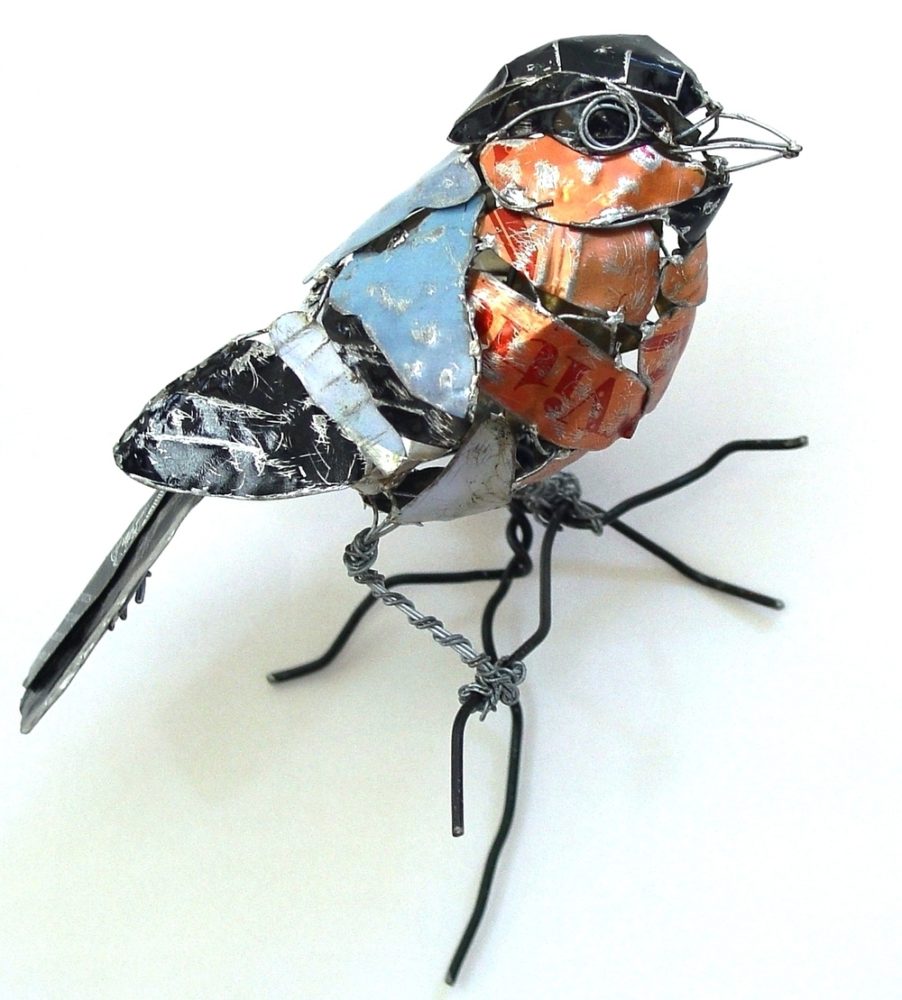
Barbara Franc. Bullfinch. [1]
Subject Choice
I chose the Gray Jay to be the subject of my sculpture. It is reasonably sized, as I intend to make my sculpture to scale, and it has a bleak color palette. This fits well with the feeling I would like my sculpture to portray. The Gray Jay can be found in Colorado and it is one of my favorite birds.
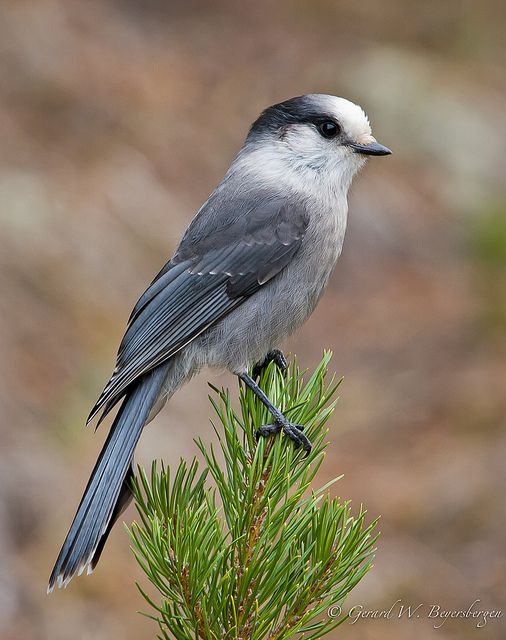
Gerry (flickr username). “Gray Jay”. 2010. flickr.
I am using specialty drink cans for the variety of colors they provide. Additionally, my project will be made out of steel wire (paper clips). The intended usage of these two materials is indicated in the concept art I have drawn below.
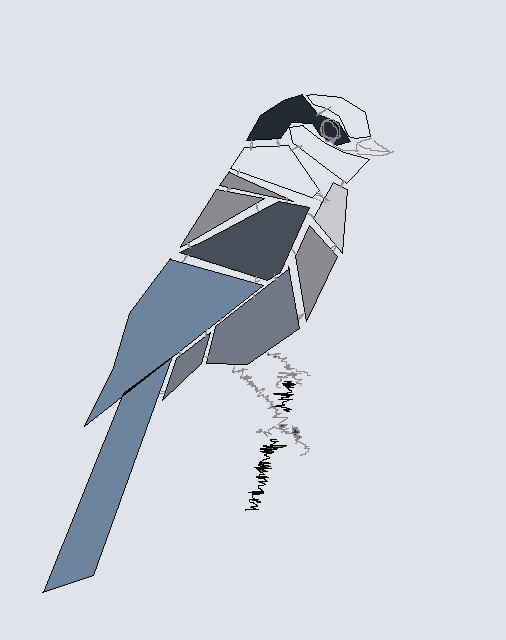
Sketch of Intended Design
I created this image in Gimp to act as a template for both the design and the materials required. The blocky sections indicate the size and color of the aluminum can shards I will be using. The gray drawn lines indicate where steel wire will be used. The black drawn lines indicate the thicker, black wire I will be using to support the sculpture. I still am in the process of collecting the materials to create the project. I wanted to start with the design to give my search for discarded cans more direction and purpose. I do not expect the materials to be difficult to obtain, but this design may be subject to change if I am unable to.
Fabrication Process
The fabrication process began with finishing the sourcing of the discarded aluminum cans. I found specialty beer cans had interesting designs on them that would contribute to making the sculpture more visually appealing. They also help match the colors of the Gray Jay. The cans I found were a large Coors Light can (silver, mountain pattern), Guinness (black), Stampede (White with black pattern), and Boulder Beer (Buffalo fur pattern). The fifth can with the blue markings was not used.
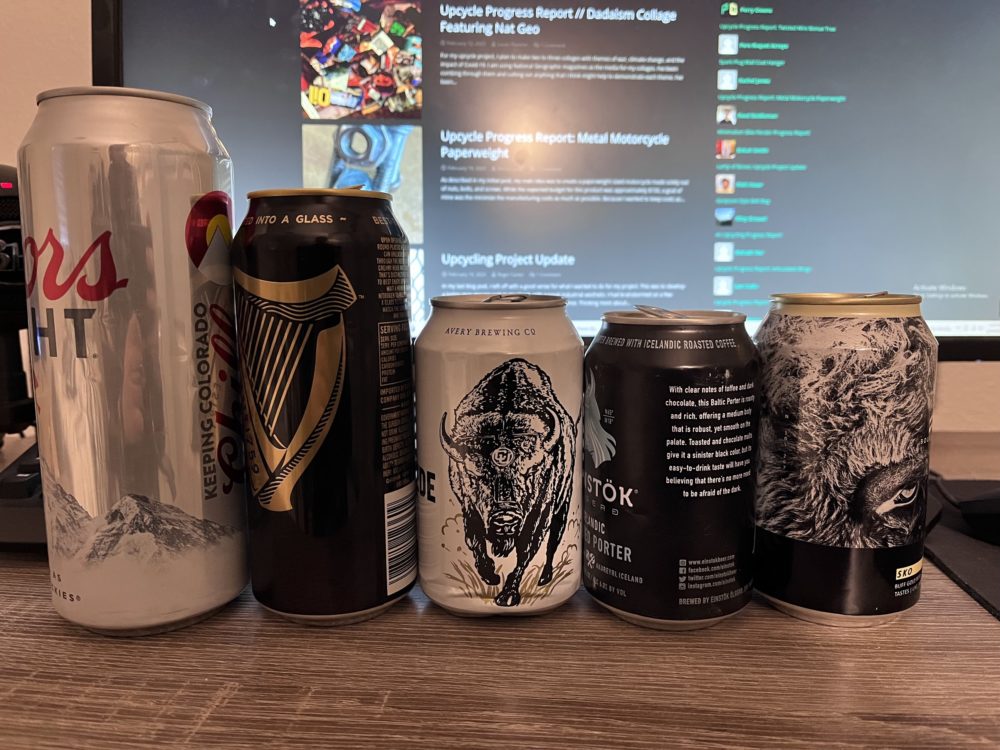
Specialty Beer Cans Sourced for Sculpture
To begin cutting out the desired shapes and patterns, the cans needed to be disassembled. First, they were washed and emptied. Next, the tops and bottoms of the cans were cut off. This was done carefully to preserve the designs on the face of the cans. The cut aluminum was extremely sharp so I took extra precaution at this step. After the tops and bottoms were removed, I made a cut length-wise down the can so they could be {“unrolled”. I made this cut in areas that would not be of interested (ingredients, barcode).
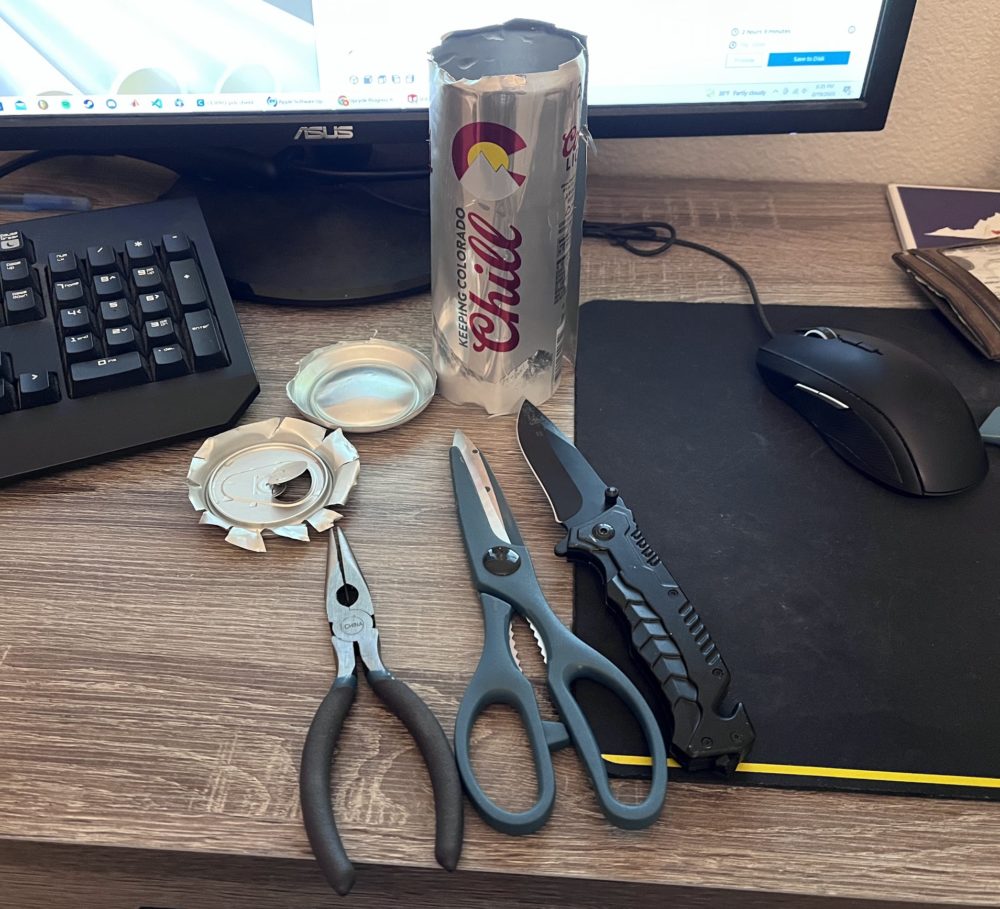
Process of Cutting Beer Cans
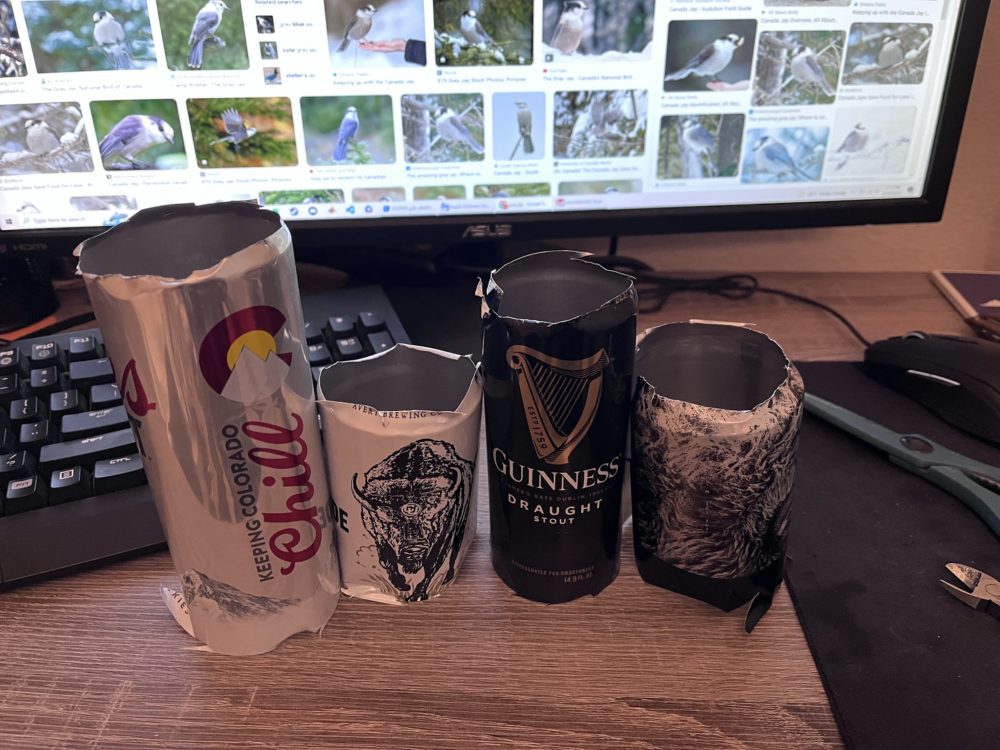
Finished Result of Cut Beer Cans
After the cans were cut and unrolled, I could begin to extract the designs I wanted. I matched up the features and colors of the designs to the parts of the Gray Jay and cut out appropriately sized sections. Two examples of this work are shown below. One shows the fur pattern of the buffalo being cut and purposed for the belly of the bird. Two shows the mountain pattern on the Coors can being used for the white fur near the birds neck.
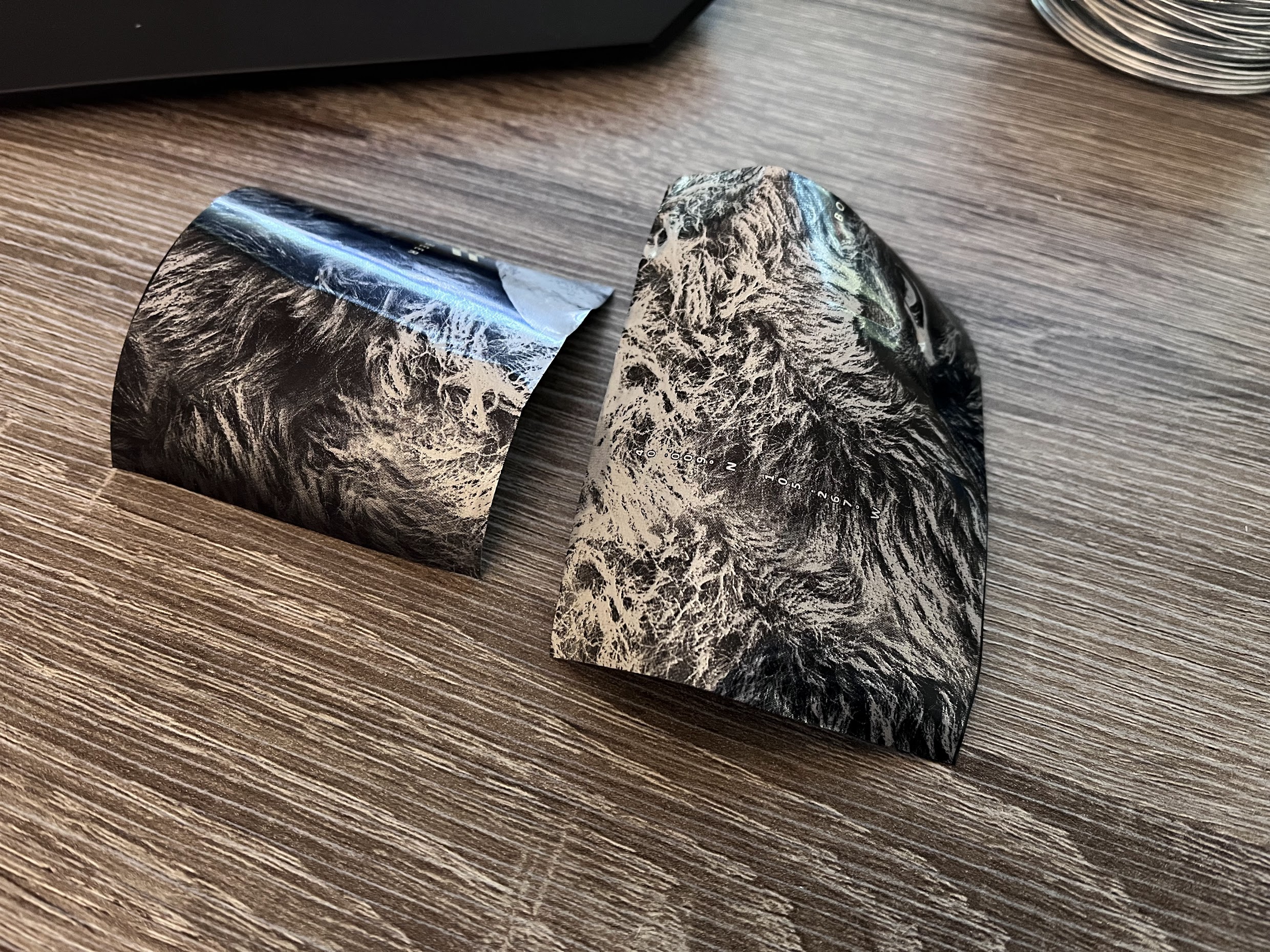
Furry Pattern
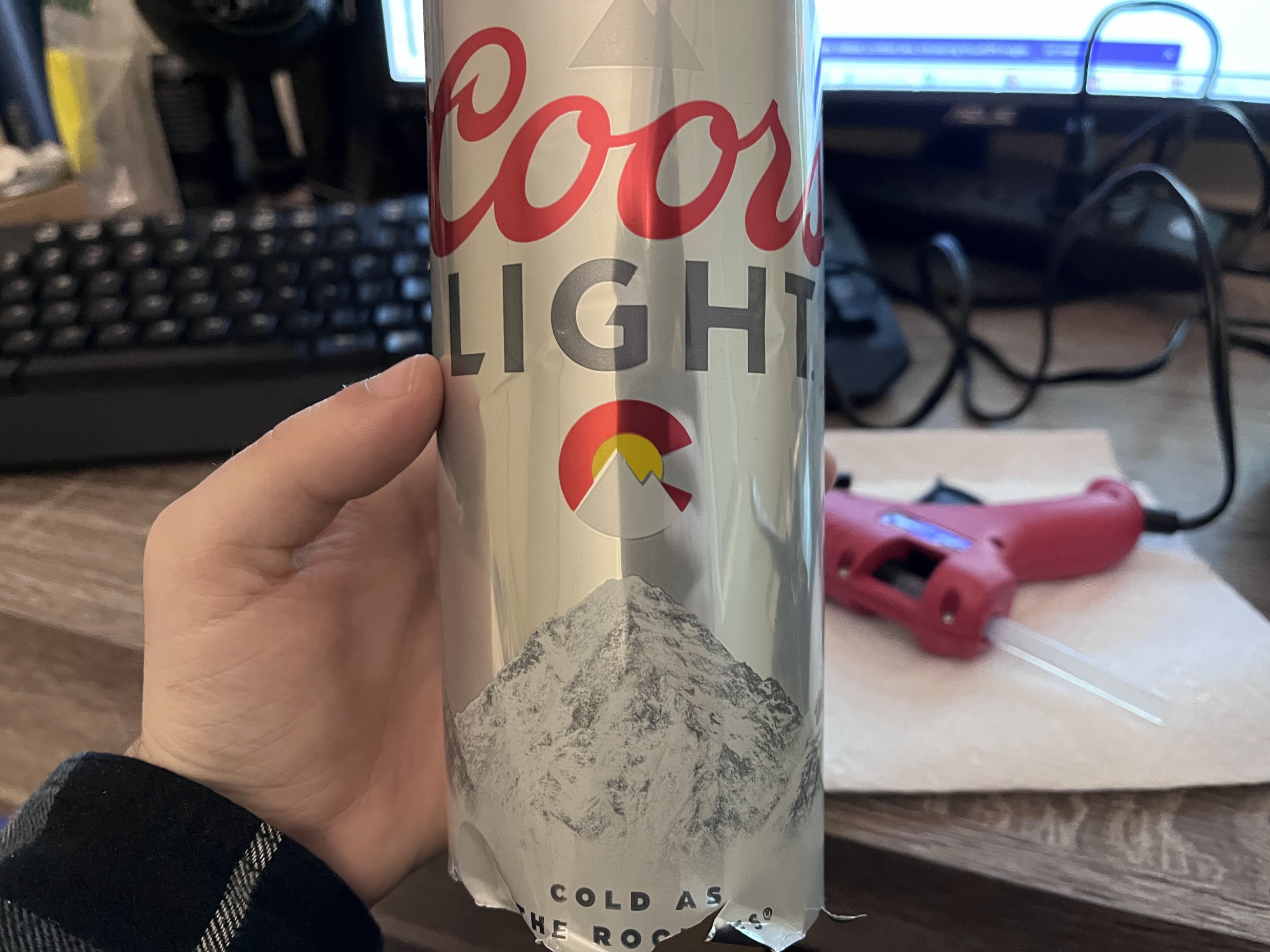
Mountain Pattern
The legs and beak of the bird were both fashioned from repurposed 20 gauge steel wire. This material was difficult to work with and did not bend easily. For this reason, the legs were made longer than anatomically correct in order toi allow for a greater range of movement after they were completed.
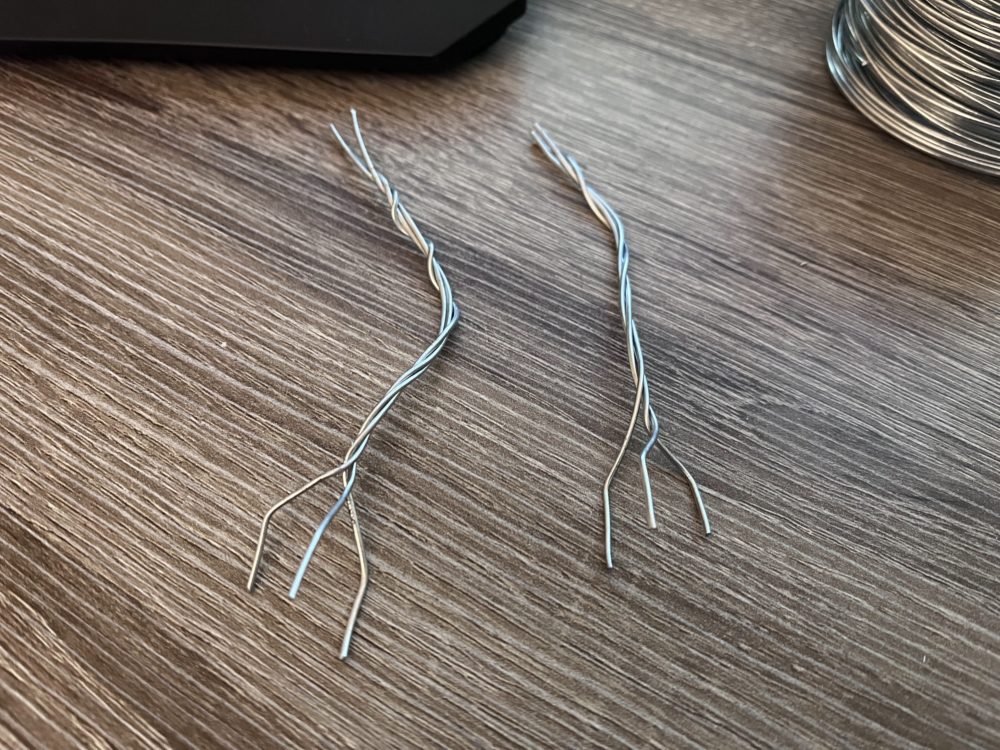
Steel Wire Legs
After the separate components were created, they could be joined together. Initially, I had planned to solder all of the joints and connections. However, I found this method to be ineffective. I had planned for this possibility and had hot glue on hand. Hot glue was not my adhesive of choice but it worked significantly better than the solder and I was able to hide the unsightly glue splotches pretty well.
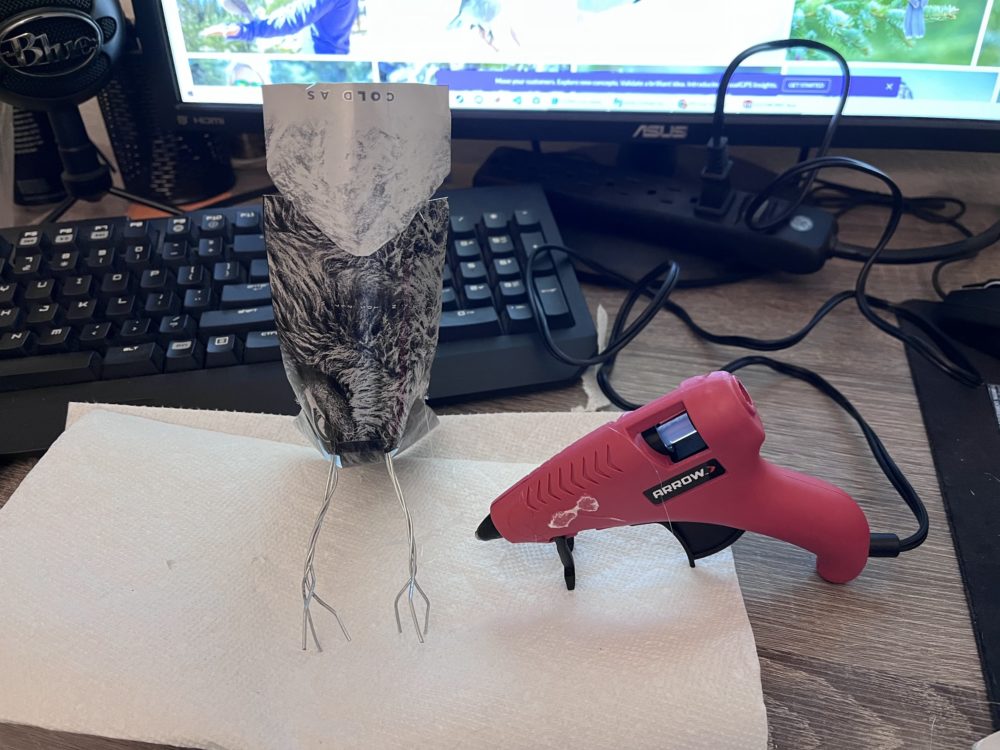
Use of Hot Glue
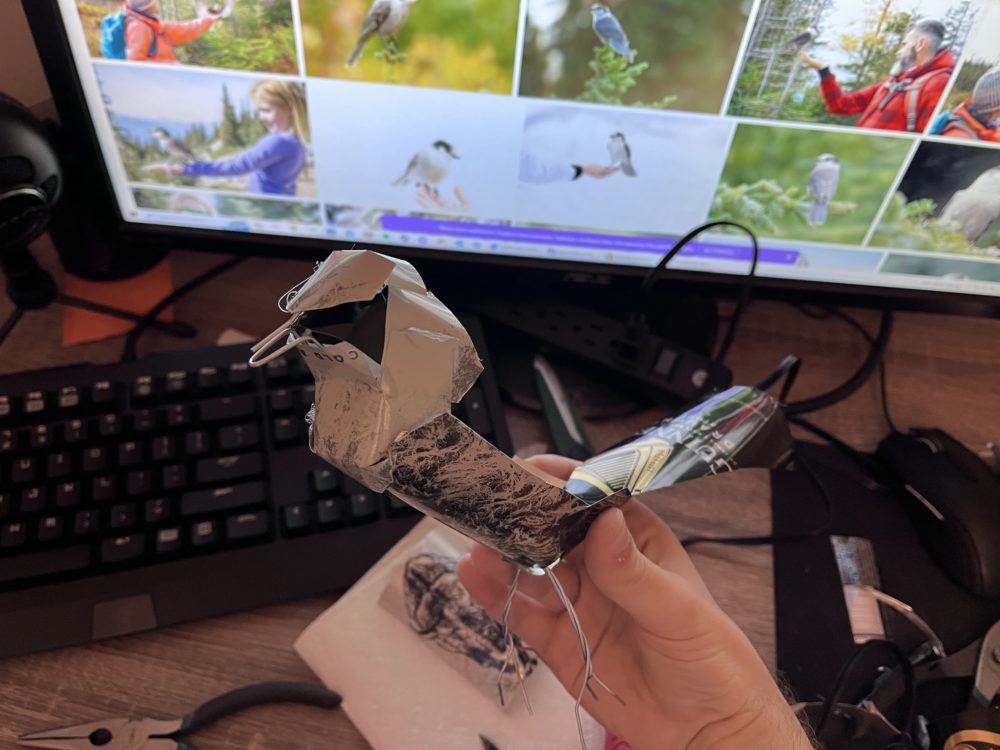
Addition of Head and Tail
Instead of using just large pieces of the cans, I instead used many little pieces all cut to shape to give better definition to the birds form. This took quite a lot longer and left a significant amount of leftover scrap aluminum. These pieces were collected and saved to be recycled later.
Final Artifact
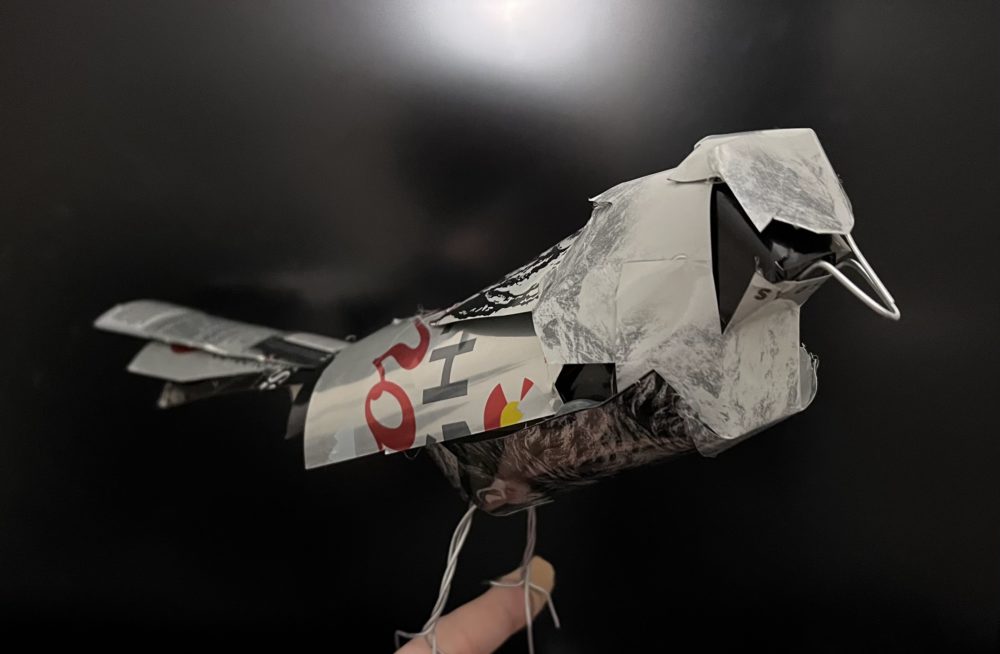
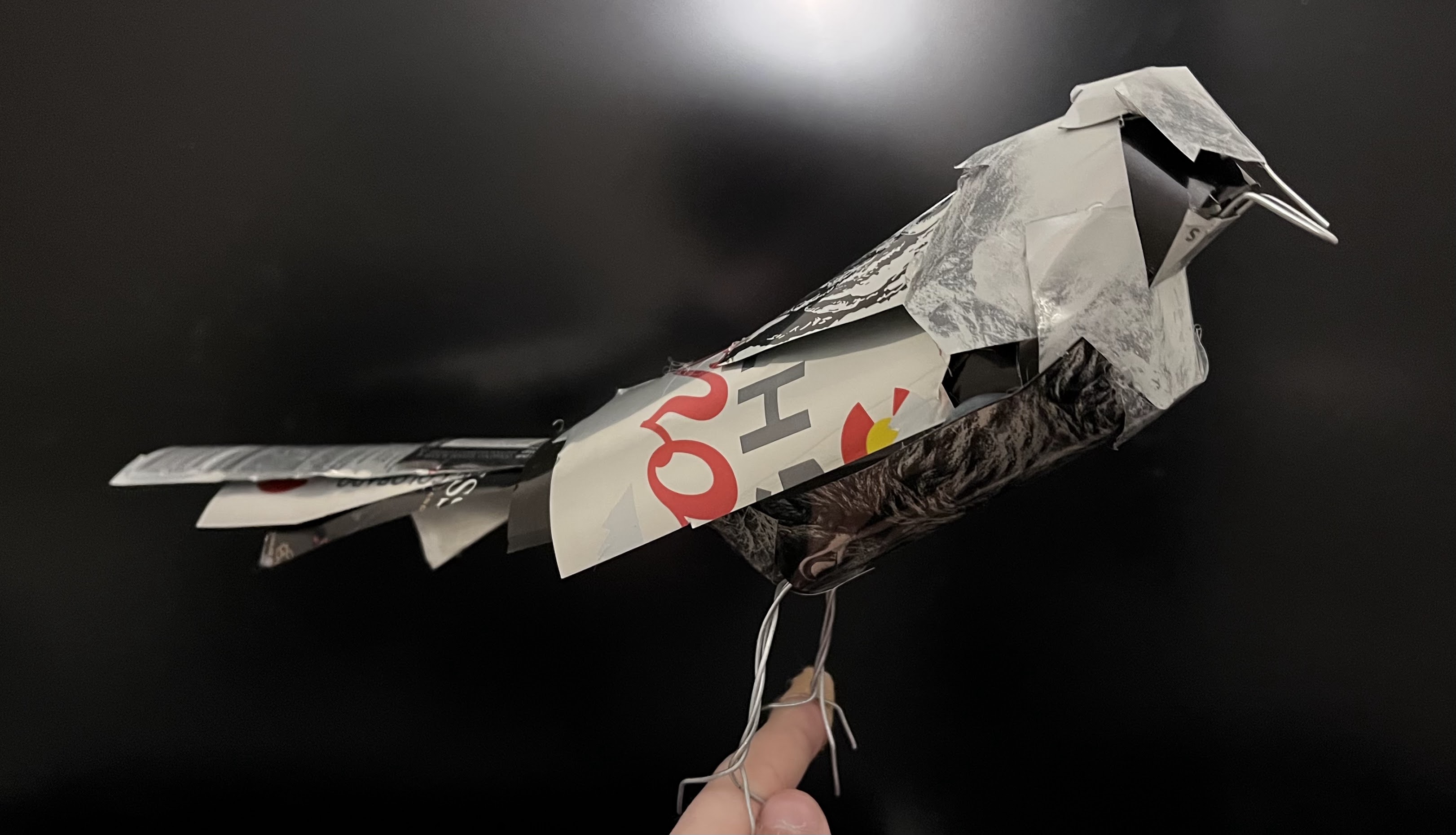
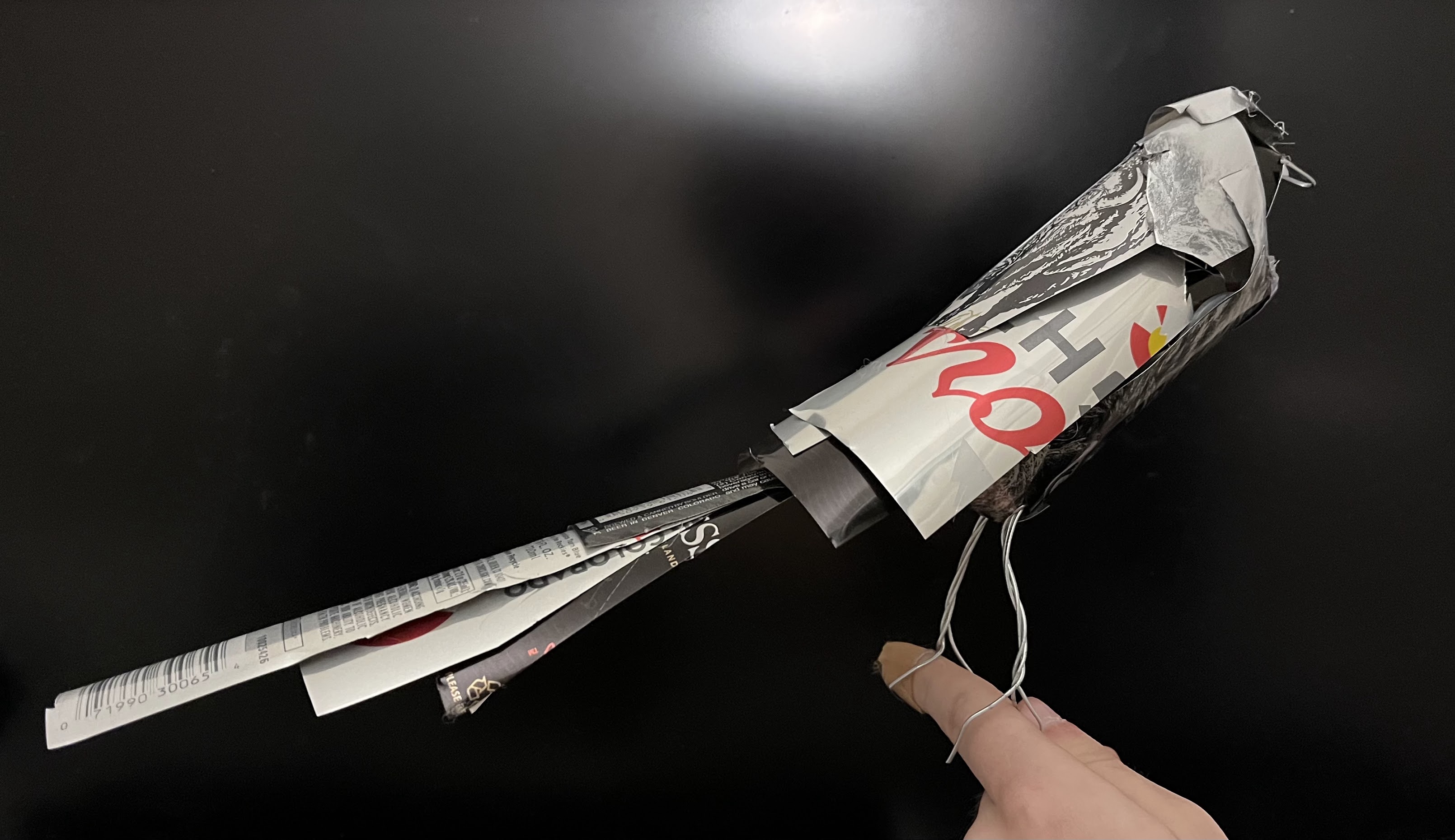
![]() Finished Sculpture
Finished Sculpture
The final artifact produced is a stark, metallic looking bird with vague features and semi-visible branding from the beer cans. This final product met both my functional and artistic goals for the sculpture. Functionally, I wanted a piece that resembled a bird made out of beer cans. I think this piece achieves that by being recognizable as a bird without a label or explanation needed. Artistically, I wanted this piece to conjure thoughts of waste and provide a refection of how human-produced trash interacts with nature. I believe the limited features, bleak color pallet, and deliberate exposure of human artifacts (logos, ingredients, barcodes) remove some aspect of nature from the piece and replaces it with thoughts of industry and garbage. The bird is shiny, metallic, and unnatural, and this accomplished my goal of creating not strictly a realism piece but a coin temporary one that evokes concern over nature.
I believe this artifact, as it is, is in its final form. I will attempt this same art piece again some day without hot glue to create a more professional piece. I will keep this piece and have already perched it on my 3D printer, where it will stay.
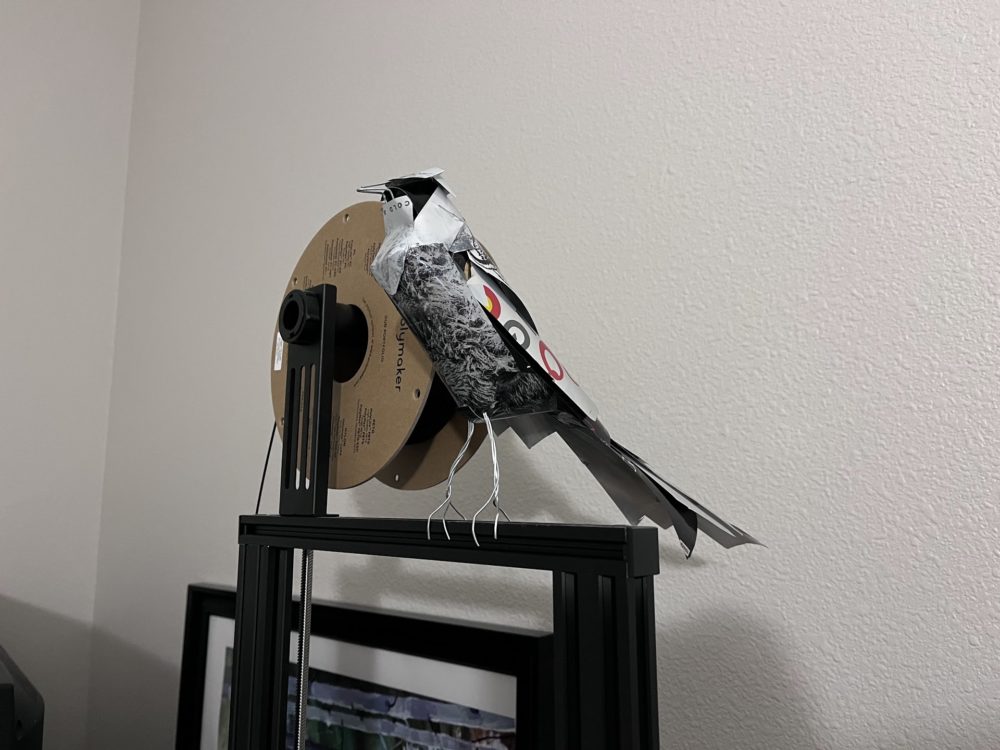
Sculpture Perched on 3D Printer
References:
Franc, Barbara. Bullfinch. https://barbarafranc.co.uk/
Gerry. (2010). “Gray Jay”. https://www.flickr.com/photos/hudsonian-godwit/6618405909/

2 Comments. Leave new
In all honesty I think the final product looked much better than both your initial design and the reference from Barbara Franc. The cans you found had the perfect design to give the bird texture on its belly and back which look very realistic. The geometric shape makes for a much more modern look, as well as the more abstract look compared to Barbara Franc’s.
And if you ever feel down, you can always look up the bird and be reminded how beautiful of a thing alcohol is.
Greetings and Salutations Nic!
Great project. I really like the 3D result of the sculpture. When I saw your first ideas, I thought it was going to be a 2D, flat, sculpture that you could hang from the wall. I think the 3D result is so much better. The colors, shape, and details are so lifelike. The painting of the breast metal is a great touch, adding feather like texture. The beak and the tail feathers are so great too. What scale is it? You say you intended to make it to scale of the real bird. How accurate is that? I like its perch on the Ender 3Pro.